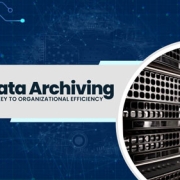Growth is a critical part of every business. To stay on top of the current landscape, innovation is key. Especially when an acquisition happens, there are decisions that need to be made regarding data integration. “The ability to store, manage, control and replicate data between the mainframe, on-premise software, and public cloud platforms in real time will allow businesses to tap into innovation—even during an acquisition,” says Milan Shetti, CEO, Rocket Software. Additionally, in an article on CIO.com Shetti shares how to manage data integration effectively during and acquisition to better manager and leverage your organization’s data.
Data synergy
“Organizations need to integrate on-premises systems, like mainframes, with cloud platforms to best manage influxes of data and stay ahead of the curve amongst competitors. With a wide range of varying data, the ability to leverage the reliability, data integrity, and scalability of the mainframe with the accessibility and collaborative benefits of the cloud is the best solution for overall data visibility and control. For this to be possible, data integration tools must also allow access to and replicate data from intricate mainframes, preserving the value of historical data. Implementing hybrid-cloud solutions also dismantles data silos that have plagued businesses for years.”
Data synchronization
“Implementing real-time synchronization capabilities into business’s storage systems is crucial to ensure that data reflects their operational realities within a rapidly changing economic landscape. Without real-time updates, IT teams could run the risk of making misinformed decisions based on outdated data, which can cost the business money. With real-time data syncing, data integration tools can run historical, on-premises data for cloud-based AI and ML analytics, which are especially important datasets that are often not utilized, especially when a company is dealing with competing priorities in an acquisition. The use of AI will only continue to rise, making this capability crucial for decision-making.”
Software development
“Software development is another crucial reason why well-managed and up-to-date data is crucial. This is especially true for quality assurance (QA) testing of companies’ applications. When organizations leverage DevOps practices in their software development processes, testing applications in isolated environments is no longer sufficient. Teams must integrate up-to-date data into the testing process to replicate real-world scenarios, which ensures that software functions as expected under various conditions. Using realistic data sets during testing allows teams to validate application performance, security, and user experience more effectively. It also enables proactive issue identification, leading to faster bug detection, reduced development time, and an overall enhancement of application performance.”
Artificial Intelligence (AI) is here and it will continue to reshape the world we live in. Bernard Marr, strategic business & technology advisor, shares an article on Forbes on the top 5 AI trends we can expect to make waves in 2024 and beyond.
5. Quantum AI. “For those new to the concept, quantum computing might feel reminiscent of a sci-fi plotline. However, it’s swiftly transitioning from the pages of fiction to the forefront of artificial intelligence research. Dive into the intricacies of qubits—quantum bits that can embody multiple states at once—and you’ll grasp their revolutionary impact on data processing. It’s not just about theoretical potential either; both emerging startups and established tech behemoths are channeling significant resources into developing quantum solutions. As 2024 unfolds, we will see monumental leaps in AI capabilities, especially in areas demanding complex problem-solving fueled by quantum advancements.”
4. AI Legislation. “AI’s unprecedented trajectory isn’t solely a fascination for tech enthusiasts—it’s now commandeering significant attention from global policymakers. As 2024 beckons, leading nations, including China, the EU, the U.S. and India, are diligently sculpting comprehensive AI policies. Their objectives are three-pronged: to catalyze technological breakthroughs, magnetize global investments, and concurrently safeguard their populace from any inadvertent AI repercussions. Conversations within the industry hint at potential international synergies, suggesting that global collaboration on AI benchmarks and norms could soon materialize.”
3. Ethical AI. “The expanding footprint of AI in our lives introduces a myriad of ethical dilemmas. As AI mechanisms increasingly inform decisions, spanning from health evaluations to financial counsel, it’s imperative that they function with utmost transparency and fairness. However, the challenge extends beyond just engineering unbiased algorithms. We must cultivate rigorous standards to ensure both these systems and their architects remain answerable for their actions. As we approach 2024, experts foresee a blossoming interest in AI ethics education and a heightened prioritization of ethical considerations within AI research and development realms.”
2. Augmented Working. “Envision AI as more than just an instrument; picture it as an invaluable ally. Imagine surgeons supplemented with AI-guided diagnostics during procedures, attorneys empowered by AI-curated case references mid-trial, or software developers aided by instantaneous, AI-propelled code suggestions. Additionally, as remote work and online education surge, AI stands poised to revolutionize tailored curriculum designs and optimize virtual team dynamics. 2024 heralds a symbiosis of human aptitude and AI prowess, amplifying both productivity and excellence.
1. Next Generation of Generative AI. “Taking the prime position on our list is the next generation of generative AI, advancing beyond the confines of simple chatbots and whimsical meme generators. We will see AI systems capable of weaving complex narratives, choreographing musical symphonies and potentially partnering in the creation of bestselling novels. A pivotal innovation in this space is multi-modal generative AI — systems adept at harmonizing various inputs like text, voice, melodies and visual cues. Picture an AI that, upon hearing a descriptive narration, can promptly draft a comprehensive article, render an illustrative image, set it to an apt musical backdrop and narrate it in multiple accents or languages. This integrative approach ushers in a myriad of opportunities, from multilayered content generation to riveting multisensory experiences. As we venture deeper into 2024, the delineation between human craftsmanship and AI-molded masterpieces will become ever more subtle, underscoring the need for discerning evaluation and genuine appreciation.”
If you have several files in the LAWDIR/productline/work directory that are taking up a lot of space and need to clean them up, most can be deleted, but be aware that the files with UPPERCASE file names are often used to transfer data to non-Lawson systems or ACH bank files, and they may be waiting to be used by a future process that has not run yet.
The following procedure is to clean up print files, work files, RQC files, user home directory files, and WebSphere trace and dump files by either running a program or by defining a recurring job that calls the program.
Automated Cleanup of Print Files, Work Files, and Other Files
Use this procedure to clean up print files, work files, RQC files, user home directory files, and WebSphere trace and dump files by either running a program or by defining a recurring job that calls the program. Before running the program or the recurring job, you must set up configuration files. These files enable you to set the cleanup options, exclude specific files from the cleanup process (by file name or by the user name associated with the files), and to specify date ranges for the files to be deleted.
The types of files to be deleted include:
- Completed job entries
- Completed jobs forms and the associated job logs
- Batch report files
- All print files from the print manager
- Files from %LAWDIR%\productline\work directory
- All user-related files from the %LAWDIR%\RQC_work, %LAWDIR%\RQC_work\log, %LAWDIR%\RQC_work\cookies directories
- Log files from the user’s home directory: %LAUNTDIR% directory
- WebSphere trace and dump (.dmp, .phd, javacore and .trc) files that are in subdirectories of the <WASHOME>\profiles directory.
To clean up print files, work files, RQC files, and other files:
- Configure the prtwrkcleanup.cfg file.
You can edit the parameters in the prtwrkcleanup.cfg file in two ways:
- By using the Lawson for Infor Ming.le Administration Tools. See Configuring Automated File Cleanupin the Lawson for Infor Ming.le Administration Guide, 10.1. (This option is only available in Lawson for Infor Ming.le 10.1.)
- By directly editing the file in the %LAWDIR%\system directory. See Directly Updating the prtwrkcleanup.cfg File.
- Configure the prtwrkcln_usrnames.cfg file.
This configuration file is divided into multiple sections:
- Section 1: usernames list for print and completed job cleanup
- Section 2: usernames list for RQC cleanup
- Section 3: usernames list for users home directory cleanup.
The script uses each different section for a different cleanup job. Make sure to put usernames in the right sections to avoid undesired outcomes.
You can enter multiple usernames in either a comma-separated format or a line-break-separated format.
For example:
Username1,Username2,Username3…
Or
Username1
Username2
Username3
Note: Do not remove the section dividers.
- Configure the prtwrkcln_exclude.cfg file.
Use this file to specify a list of file names to be excluded from the work file cleanup process.
You can enter multiple file names in either a comma-separated format or a line-break-separated format.
For example:
Filename1,Filename2,Filename3…
Or
Filename1
Filename2
Filename3
- If you want to run the cleanup program just once, open a command line session and follow the substeps below. (Note that a recurring job may be more useful in the long term. See the next main step below.)
- Ensure that the prtwrkcln executable exists in %GENDIR%\bin.
- In a command line session, navigate to %GENDIR%\bin.
- At the command line, enter the following command:
prtwrkcln.exe
- If you want to run the cleanup program via a recurring job, use the following substeps.
- In Lawson for Infor Ming.le, navigate to Bookmarks> Jobs and Reports > Multi-step Job Definition.
- Specify this information to define a multi-step job.
Job Name
Specify a name for the multi-step job.
Job Description
Specify a description for the multi-step job.
User Name
Displays the name of the user defining the job.
Form
Specify prtwrkcln. (This assumes this form ID exists. Use the For ID Definition utility (tokendef) to check if it exists and to add it as an environment form ID if necessary.)
Step Description
Specify a description for the step.
- Click Addto save the new job.
- Navigate to Related Forms> Recurring Job Definition. Define a recurring job according to the instructions in the “Recurring Jobs” topic in Infor Lawson Administration: Jobs and Reports.
While we still have two months left of 2023, we must look ahead at the ever changing field of technology to see what is in store. “For the past few years and through 2023, the number of organizations that started to work with AI has exploded. This is not expected to slow down,” said Gartner Vice President Analyst Bart Willemsen, in an email interview with TechRepublic. Tech expert Esther Shein shares a list on Gartner of the top strategic trends we should keep close watch in 2024.
- Democratized generative AI.
- AI trust, risk and security management.
- AI-augmented development.
- Intelligent applications.
- Augmented-connected workforce.
- Machine customers.
- Continuous threat exposure management.
- Sustainable technology.
- Platform engineering.
- Industry cloud platforms.
Infor recently announced that Wayne HealthCare has successfully upgraded its financials and interoperability capabilities to the cloud. According to the press release, with the help of Infor partner GForce Technology Consulting, Wayne HealthCare has been able to migrate critical back-office applications quickly, and set up its teams on new and modern cloud solutions, powered by AWS, that will allow them to stay agile for steady growth, while continuing to provide world-class patient care to the community. Additionally, Infor has helped Wayne HealthCare streamline processes in near real time, to help drive adoption, compliance and productivity. Infor’s next-generation Financials & Supply Management (FSM) applications are role based, data driven, consumer inspired, and mobile enabled, and will help teams at the organization understand better key business drivers and visualize changes that will drive growth. Moreover, Infor Clinical Bridge bridged the divide between clinical and business systems at the organization to streamline operations, reduce supply expense, and maximize staff productivity. Powered by the Infor Cloverleaf Integration engine, Clinical Bridge is a managed integration service that quickly establishes secure connectivity among an electronic health record (EHR) system and business applications, and it maintains that connectivity to maximize uptime. This near real-time integration enables Wayne HealthCare to reduce errors and exceptions, eliminate manual data entry and paperwork, streamline workflows, and reduce supply expenses.
If you have several files in the LAWDIR/productline/work directory that are taking up a lot of space and need to clean them up, most can be deleted, but be aware that the files with UPPERCASE file names are often used to transfer data to non-Lawson systems or ACH bank files, and they may be waiting to be used by a future process that has not run yet.
The following procedure is to clean up print files, work files, RQC files, user home directory files, and WebSphere trace and dump files by either running a program or by defining a recurring job that calls the program.
Automated Cleanup of Print Files, Work Files, and Other Files
Use this procedure to clean up print files, work files, RQC files, user home directory files, and WebSphere trace and dump files by either running a program or by defining a recurring job that calls the program. Before running the program or the recurring job, you must set up configuration files. These files enable you to set the cleanup options, exclude specific files from the cleanup process (by file name or by the user name associated with the files), and to specify date ranges for the files to be deleted.
The types of files to be deleted include:
- Completed job entries
- Completed jobs forms and the associated job logs
- Batch report files
- All print files from the print manager
- Files from $LAWDIR/productline/work directory
- All user-related files from the $LAWDIR/RQC_work, $LAWDIR/RQC_work/log, $LAWDIR/RQC_work/cookies directories
- WebSphere trace and dump (.dmp, .phd, javacore and .trc) files that are in subdirectories of the <WASHOME>/profiles directory.
To clean up print files, work files, RQC files, and other files:
- Configure the prtwrkcleanup.cfg file.
You can edit the parameters in the prtwrkcleanup.cfg file in two ways:
-
- By using the Lawson for Infor Ming.le Administration Tools. See Configuring Automated File Cleanupin the Lawson for Infor Ming.le Administration Guide, 10.1. (This option is only available in Lawson for Infor Ming.le 10.1.)
- By directly editing the file in the $LAWDIR/system directory. See Directly Updating the prtwrkcleanup.cfg File.
- Configure the prtwrkcln_usrnames.cfg file.
This configuration file is divided into multiple sections:
-
- Section 1: usernames list for print and completed job cleanup
- Section 2: usernames list for RQC cleanup
- Section 3: usernames list for users home directory cleanup.
The script uses each different section for a different cleanup job. Make sure to put usernames in the right sections to avoid undesired outcomes.
You can enter multiple usernames in either a comma-separated format or a line-break-separated format.
For example:
Username1,Username2,Username3…
Or
Username1
Username2
Username3
Note: Do not remove the section dividers.
- Configure the prtwrkcln_exclude.cfg file.
Use this file to specify a list of file names to be excluded from the work file cleanup process.
You can enter multiple file names in either a comma-separated format or a line-break-separated format.
For example:
Filename1,Filename2,Filename3…
Or
Filename1
Filename2
Filename3
- If you want to run the cleanup program just once, open a command line session and follow the substeps below. (Note that a recurring job may be more useful in the long term. See the next main step below.)
- Ensure that the prtwrkcln executable exists in $GENDIR/bin.
- In a command line session, navigate to $GENDIR/bin.
- At the command line, enter the following command:
- Ensure that the prtwrkcln executable exists in $GENDIR/bin.
prtwrkcln.
- If you want to run the cleanup program via a recurring job, use the following substeps.
- In Lawson for Infor Ming.le, navigate to Bookmarks> Jobs and Reports > Multi-step Job Definition.
- Specify this information to define a multi-step job.
- In Lawson for Infor Ming.le, navigate to Bookmarks> Jobs and Reports > Multi-step Job Definition.
Job Name
Specify a name for the multi-step job.
Job Description
Specify a description for the multi-step job.
User Name
Displays the name of the user defining the job.
Form
Specify prtwrkcln. (This assumes this form ID exists. Use the For ID Definition utility (tokendef) to check if it exists and to add it as an environment form ID if necessary.)
Step Description
Specify a description for the step.
- Click Addto save the new job.
- Navigate to Related Forms> Recurring Job Definition. Define a recurring job according to the instructions in the “Recurring Jobs” topic in Infor Lawson Administration: Jobs and Reports.










